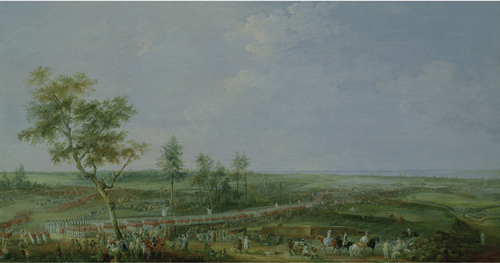
Charles Willson Peale, George Washington, 1772. The earliest known portrait of Washington shows him wearing his uniform as colonel of the Virginia Regiment from 1755 to 1758.

Anonymous, Lawrence Washington, ca. 1740–50. Washington’s much-loved half brother wears the red coat and green waistcoat of the American Regiment in which he served as a captain in the Caribbean from 1740 to 1742.

Duncan Smith, Sarah “Sally” Cary Fairfax. This 1916 copy of a naïve, and now lost, portrait by an anonymous artist suggests the qualities that captivated the young Washington.

Sir Joshua Reynolds, Captain Robert Orme, 1756. This dashing young British officer befriended Washington during the 1755 campaign against Fort Duquesne.

Allan Ramsay, John Campbell, Fourth Earl of Loudoun, 1754. Britain’s commander in chief in North America from mid-1756 to early 1758 failed to afford Washington the patronage he expected.

William Mercer, after James Peale, The Battle of Princeton, c. 1786. Washington rallies his troops at the crisis of the fighting on January 3, 1777.

Xavier della Gatta, The Battle of Germantown, 1782. Early on October 4, 1777, redcoats prepare to defend the Chew House against the Americans, seen advancing in the distance.

Charles Willson Peale, George Washington at Princeton, 1779. This celebrated portrait commemorates Washington’s pivotal victory on January 3, 1777. Hessian standards captured days earlier at Trenton lie at his feet.

Charles Willson Peale, General Nathanael Greene, 1783. Widely regarded as Washington’s most able subordinate, Greene shared his instinctive aggression.

Charles Willson Peale, General Henry Knox, 1783. Washington’s loyal artillery commander, shown wearing the insignia of the newly inaugurated Society of the Cincinnati.

General Sir William Howe, mezzotint published by John Morris, c. 1777. Washington’s brave but sometimes lackadaisical British opponent during the campaigns of 1776 to 1777.

John Smart, Sir Henry Clinton, 1777. Howe’s erratic successor, and Washington’s principal enemy from 1778.

Thomas Gainsborough, Charles Earl Cornwallis, 1783. A deceptively tranquil portrait of the energetic general trapped at Yorktown in 1781.

James Peale, General Horatio Gates at Saratoga, c. 1799. Washington’s colleague and rival at his greatest triumph, the surrender of General Burgoyne’s army on October 17, 1777.

George Romney, Joseph Brant, c. 1776. Society artist Romney painted the charismatic Mohawk leader when Brant visited London.

H. Charles Mcbarron Junior, Washington at Monmouth Courthouse. A modern reconstruction of the battle on June 28, 1778, with Washington berating Charles Lee for retreating. The artist captures the day’s intense heat, and the motley uniforms of the Continental Army.

Major John André, Self–portrait, 1780. Made on the eve of his execution on October 2, 1780, André’s sketch reveals the debonair and carefree demeanor that so impressed his captors.

John Trumbull, Surrender of Lord Cornwallis, 1787–1828. Deputizing for Lord Cornwallis at Yorktown on October 19, 1781, Brigadier General O’Hara capitulates to Major General Lincoln, while Washington looks on.

Louis–Nicolas van Blarenberghe, The British Surrender at Yorktown, 1785. The garrison marches out to lay down its arms, watched by smartly uniformed French troops (left) and ragged Americans.

Gilbert Stuart, George Washington, “Athenaeum type”, 1796. Perhaps the most familiar likeness of Washington, Stuart’s portrait depicts features rendered puffy and distorted by badly–fitting false teeth.

Attributed to Frederick Kemmelmeyer, Washington Reviewing the Western Army at Fort Cumberland, Maryland, after 1794. Against the backdrop of the Allegheny Mountains militia assemble on October 16, 1794 to counter the Whiskey Rebels. Wearing an updated version of his old Revolutionary War uniform, Washington rides a horse of his favorite color.

John Trumbull, George Washington, 1780. The lean and vigorous forty-eight-year-old Washington shadowed by Billy Lee, his slave and constant companion during the Revolutionary War.